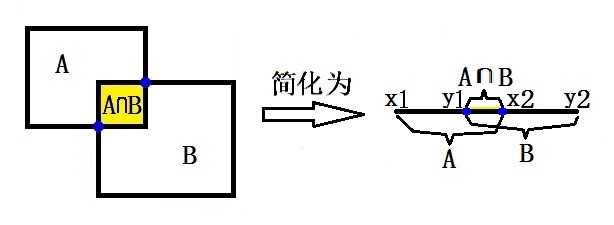现在目标检测、语义分割太火了,方法很重要,但是如何测评不同方法之间的好坏也是需要注意的问题,一个比较完备的任务可以在“水”文章的时候更快(高被引的文章需要量变引起质变…)。一般在各大榜单上采用相同的指标进行比较,本文就来看看都有哪些计算指标,以及其是如何计算的。
前序
几个名词:
TP:真阳类,FP:假阳类,FN:假阴类,TN:真阴类
- Precision,Recall,F1 Score,iou,map都是越大越好,PR曲线越靠近右上角越好。
目标检测中的算法性能评估指标
- 判断标准就是靠IOU的阈值判断,如果IOU大于设定的阈值,判定为positive;
TP:某类被正确检测出来
FP:错分为某类
FN:某类没有被检测出来
TN:目标检测没有这个属性
Precision
P r e c i s i o n = T P T P + F P Precision = \frac{TP}{TP+FP} Precision=TP+FPTP
Recall
R e c a l l = T P T P + F N Recall = \frac{TP}{TP+FN} Recall=TP+FNTP
PR曲线
Accuracy
A c c u r a c y = T P + T N T P + T N + F P + F N Accuracy=\frac{TP+TN}{TP+TN+FP+FN} Accuracy=TP+TN+FP+FNTP+TN
IOU
推荐一篇博客,我觉着写的很好传送门
C++代码,参考的Yolo开源代码中的实现方式,由于bbox中记录到的信息是不同的,因此实现方式略有不同。
一维原理图:
C++代码实现:
struct BoundingBox {
float x1, y1, x2, y2;
BoundingBox (float a, float b, float c, float d) :x1(a), y1(b), x2(c), y2(d) {}
};
float box_iou(BoundingBox a, BoundingBox b) {
float xx1 = max(a.x1, b.x1);
float yy1 = max(a.y1, b.y1);
float xx2 = min(a.x2, b.x2);
float yy2 = min(a.y2, b.y2);
float areaa = (a.x2 - a.x1)*(a.y2 - a.y1);
float areab = (b.x2 - b.x1)*(b.y2 - b.y1);
float ovr = max(float(0), xx2 - xx1)*max(float(0), yy2 - yy1);
return ovr / (areaa + areab - ovr);
}
mAP
直接看一个经典目标检测比赛“The Pascal Visual Object Classes (VOC) Challenge”中如何定义的:
Recall is defined as the proportion of all positive examples ranked above a given rank. Precision is the proportion of all examples above that rank which are from the positive class. The AP summarises the shape of the precision/recall curve, and is defined as the mean precision at a set of eleven equally spaced recall levels [0, 0.1,…,1]:
A P = 1 11 ∑ r ∈ { 0 , 0.1 , . . . , 1 } p i n t e r p ( r ) AP= \frac{1}{11}\sum_{r \in \{0,0.1,…,1\}} p_{interp}(r) AP=111r∈{
0,0.1,…,1}∑pinterp(r)
The precision at each recall level r is interpolated by taking the maximum precision measured for a method for which the corresponding recall exceeds r:
p i n t e r p ( r ) = max r ~ : r ~ ≥ r p ( r ~ ) p_{interp}(r)=\max_{\widetilde{r} : \widetilde{r} \geq {r}}p(\widetilde{r}) pinterp(r)=r
:r
≥rmaxp(r
)
where p ( r ~ ) p(\widetilde{r}) p(r
) is the measured precision at recall r ~ \widetilde{r} r
.
The intention in interpolating the precision/recall curve in this way is to reduce the impact of the “wiggles” in the precision/recall curve, caused by small variations in the ranking of examples.
全称是:mean average precision,因此为了求解mAP就需要知道每个类别的AP,以及每个类别在不同IOU阈值下的精度的总和,再求均值。
除此之外,还有 m A P 25 , m A P 50 {mAP_{25}},{mAP_{50}} mAP25,mAP50分别表示在IOU阈值为0.25和0.5的条件下的平均精度。
- 代码实现:这里,这里,yolo中应该也有,但是我没找到。其他常见的目标检测框架,COCO中应该也有相应的集成好的实现了!
F1 Score
F 1 = 2 × P × R P + R = 2 × T P 2 × T P + F P + F N F_1= 2 \times \frac{P \times R}{P+R}=\frac{2\times TP}{2\times TP+FP+FN} F1=2×P+RP×R=2×TP+FP+FN2×TP
语义分割算法性能评估指标
在语义分割中相当于是多分类的任务,每个点都有自己的类别,那么TP表示的就是真的被分为某类的概率,其他同理。在某个场景中,这里的TP就是正确分割的点数。
Precision
同目标检测的Precision
Recall
同目标检测的Recall
F1 Score
同目标检测的F1 Score
IOU
I O U = 正确分为某类的 被分为该类 ∪ 被错分成其他类的 = T P T P + F P + F N IOU=\frac{正确分为某类的}{被分为该类 \cup 被错分成其他类的}=\frac{TP}{TP+FP+FN} IOU=被分为该类∪被错分成其他类的正确分为某类的=TP+FP+FNTP
检索、位置识别算法性能评估指标
Recall@N
给定一个query的数据,在database中进行搜索(即kdtree,从Scikit-learn或者faiss中都可以),返回N个值,如果在真值文件中存在一个,便认为query是检索正确。
R e c a l l @ N = N s e a r c h _ s u c c e e d N t o t a l _ n u m b e r _ o f _ q u e r y Recall@N=\frac{N_{search\_succeed}}{N_{total\_number\_of\_query}} Recall@N=Ntotal_number_of_queryNsearch_succeed
Recall@1%
1%即全部query中的1%个,在不同的database中,其值是动态变化的,在RobotCar中一班Recall@1%就是Recall@5左右的值。
点云配准算法性能评估指标
如果是刷榜,那么两个点云之间是有真值的, T g t T^{gt} Tgt, T ^ \hat{T} T^是算法得到的估计值。两个变换矩阵之间的偏差可以用如下指标来衡量:
Δ T = T ^ ( T g t ) − 1 = [ Δ R Δ t 0 T 1 ] \Delta T = \hat{T}(T^{gt})^{-1}= \left[ \begin{array}{cc} \Delta R & \Delta t \\ 0^{T} & 1 \end{array} \right] ΔT=T^(Tgt)−1=[ΔR0TΔt1]
旋转误差
E r r o r R = a r c c o s ( t r ( Δ R ) − 1 2 ) , t r 表示矩阵的迹 Error_R=arccos( \frac{tr(\Delta R)-1}{2}),tr表示矩阵的迹 ErrorR=arccos(2tr(ΔR)−1),tr表示矩阵的迹
平移误差
E r r o r t = ∣ ∣ Δ t ∣ ∣ 2 , ∣ ∣ ⋅ ∣ ∣ 2 表示 2 范数 Error_t=|| \Delta t ||_2,|| \cdot ||_2 表示2范数 Errort=∣∣Δt∣∣2,∣∣⋅∣∣2表示2范数
相对平移误差Relative Translational Error(RTE)
RRE是另外一种计算误差的方式,相比于上面计算的旋转误差,应该是等价的。RRE是在Euler角三个分量的绝对误差之和。
E R = Σ i = 1 3 ∣ γ ( i ) ∣ E_R=\Sigma_{i=1}^3 | \gamma (i)| ER=Σi=13∣γ(i)∣
where γ = F ( R g t − 1 R E ) \gamma=F(R_{gt}^{-1}R_E) γ=F(Rgt−1RE) is the euler angle of rotation matrix R g t − 1 R E R_{gt}^{-1}R_E Rgt−1RE.
相对旋转误差Relative Rotational Error (RRE)
E t = ∥ t g t − t E ∥ 2 E_t=\| \mathbf{t}_{gt} -\mathbf{t}_E\|_2 Et=∥tgt−tE∥2
References
- https://www.cnblogs.com/Tom-Ren/p/11054605.html
今天的文章目标识别的方法和分类_目标识别的方法和分类分享到此就结束了,感谢您的阅读。
版权声明:本文内容由互联网用户自发贡献,该文观点仅代表作者本人。本站仅提供信息存储空间服务,不拥有所有权,不承担相关法律责任。如发现本站有涉嫌侵权/违法违规的内容, 请发送邮件至 举报,一经查实,本站将立刻删除。
如需转载请保留出处:https://bianchenghao.cn/63873.html

